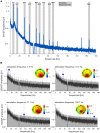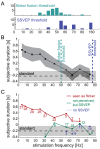How long depends on how fast--perceived flicker dilates subjective duration
- PMID: 24194829
- PMCID: PMC3806760
- DOI: 10.1371/journal.pone.0076074
How long depends on how fast--perceived flicker dilates subjective duration
Abstract
How do humans perceive the passage of time and the duration of events without a dedicated sensory system for timing? Previous studies have demonstrated that when a stimulus changes over time, its duration is subjectively dilated, indicating that duration judgments are based on the number of changes within an interval. In this study, we tested predictions derived from three different accounts describing the relation between a changing stimulus and its subjective duration as either based on (1) the objective rate of changes of the stimulus, (2) the perceived saliency of the changes, or (3) the neural energy expended in processing the stimulus. We used visual stimuli flickering at different frequencies (4-166 Hz) to study how the number of changes affects subjective duration. To this end, we assessed the subjective duration of these stimuli and measured participants' behavioral flicker fusion threshold (the highest frequency perceived as flicker), as well as their threshold for a frequency-specific neural response to the flicker using EEG. We found that only consciously perceived flicker dilated perceived duration, such that a 2 s long stimulus flickering at 4 Hz was perceived as lasting as long as a 2.7 s steady stimulus. This effect was most pronounced at the slowest flicker frequencies, at which participants reported the most consistent flicker perception. Flicker frequencies higher than the flicker fusion threshold did not affect perceived duration at all, even if they evoked a significant frequency-specific neural response. In sum, our findings indicate that time perception in the peri-second range is driven by the subjective saliency of the stimulus' temporal features rather than the objective rate of stimulus changes or the neural response to the changes.
Conflict of interest statement
Figures





Similar articles
-
Effect of change saliency and neural entrainment on flicker-induced time dilation.J Vis. 2020 Jun 3;20(6):15. doi: 10.1167/jov.20.6.15. J Vis. 2020. PMID: 32574359 Free PMC article.
-
Flicker-Induced Time Dilation Does Not Modulate EEG Correlates of Temporal Encoding.Brain Topogr. 2015 Jul;28(4):559-69. doi: 10.1007/s10548-014-0389-z. Epub 2014 Aug 13. Brain Topogr. 2015. PMID: 25117576
-
Transient twinkle perception is induced by sequential presentation of stimuli that flicker at frequencies above the critical fusion frequency.Atten Percept Psychophys. 2015 Nov;77(8):2711-27. doi: 10.3758/s13414-015-0962-x. Atten Percept Psychophys. 2015. PMID: 26198710
-
Is subjective duration a signature of coding efficiency?Philos Trans R Soc Lond B Biol Sci. 2009 Jul 12;364(1525):1841-51. doi: 10.1098/rstb.2009.0026. Philos Trans R Soc Lond B Biol Sci. 2009. PMID: 19487187 Free PMC article. Review.
-
Neuropsychological and Neurophysiological Mechanisms behind Flickering Light Stimulus Processing.Biology (Basel). 2022 Nov 28;11(12):1720. doi: 10.3390/biology11121720. Biology (Basel). 2022. PMID: 36552230 Free PMC article. Review.
Cited by
-
Effect of change saliency and neural entrainment on flicker-induced time dilation.J Vis. 2020 Jun 3;20(6):15. doi: 10.1167/jov.20.6.15. J Vis. 2020. PMID: 32574359 Free PMC article.
-
The Amount of Time Dilation for Visual Flickers Corresponds to the Amount of Neural Entrainments Measured by EEG.Front Comput Neurosci. 2018 May 7;12:30. doi: 10.3389/fncom.2018.00030. eCollection 2018. Front Comput Neurosci. 2018. PMID: 29867423 Free PMC article.
-
The WACDT, a modern vigilance task for network defense.Front Neuroergon. 2023 Nov 21;4:1215497. doi: 10.3389/fnrgo.2023.1215497. eCollection 2023. Front Neuroergon. 2023. PMID: 38234483 Free PMC article.
-
Periodic Fluctuation of Perceived Duration.Iperception. 2018 Mar 8;9(2):2041669518760625. doi: 10.1177/2041669518760625. eCollection 2018 Mar-Apr. Iperception. 2018. PMID: 29755719 Free PMC article.
-
Modulation of Individual Alpha Frequency with tACS shifts Time Perception.Cereb Cortex Commun. 2020 Sep 8;1(1):tgaa064. doi: 10.1093/texcom/tgaa064. eCollection 2020. Cereb Cortex Commun. 2020. PMID: 34296127 Free PMC article.
References
-
- Buhusi C, Meck W (2005) What makes us tick? functional and neural mechanisms of interval timing. Nature Reviews Neuroscience 6: 755–765. - PubMed
-
- Grondin S (2010) Timing and time perception: a review of recent behavioral and neuroscience findings and theoretical directions. Attention, Perception, & Psychophysics 72: 561–582. - PubMed
-
- Kelly S (2005) The puzzle of temporal experience. In: Brook A, Akins K, editors, Cognition and the brain: The philosophy and neuroscience movement, Cambridge University Press. pp. 218–248.
-
- Guyau J (1890) La genèse de l'idée de temps. Alcan, Paris.
-
- Roeckelein J (2000) The concept of time in psychology: A resource book and annotated bibliography. Greenwood Pub Group, Westport, CT, USA.
Publication types
MeSH terms
LinkOut - more resources
Full Text Sources
Other Literature Sources

